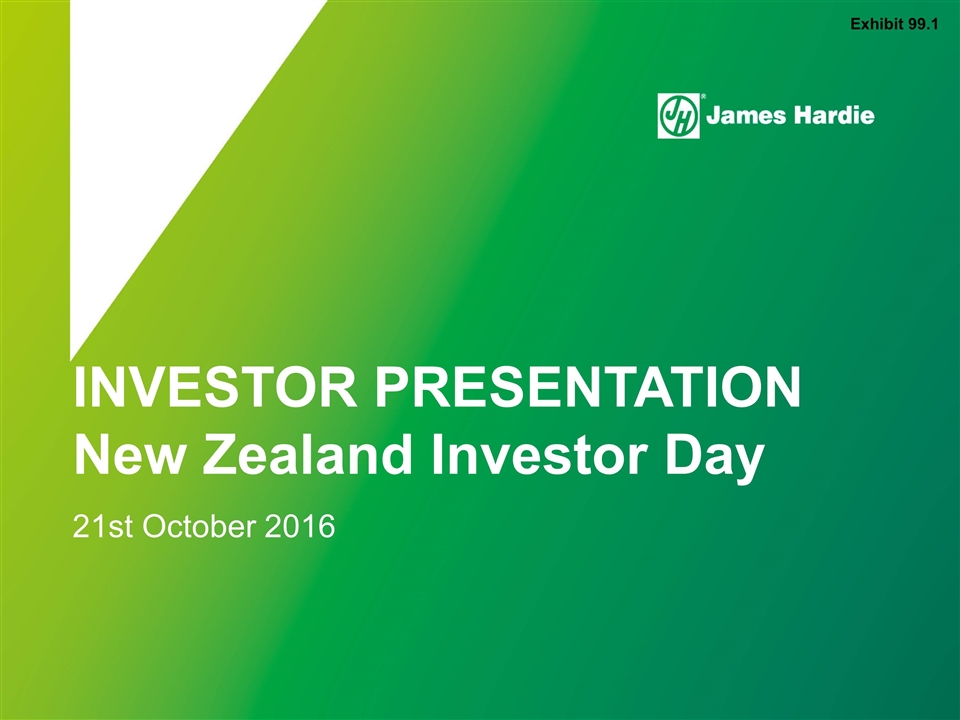

INVESTOR PRESENTATION New Zealand Investor Day 21st October 2016 Exhibit 99.1
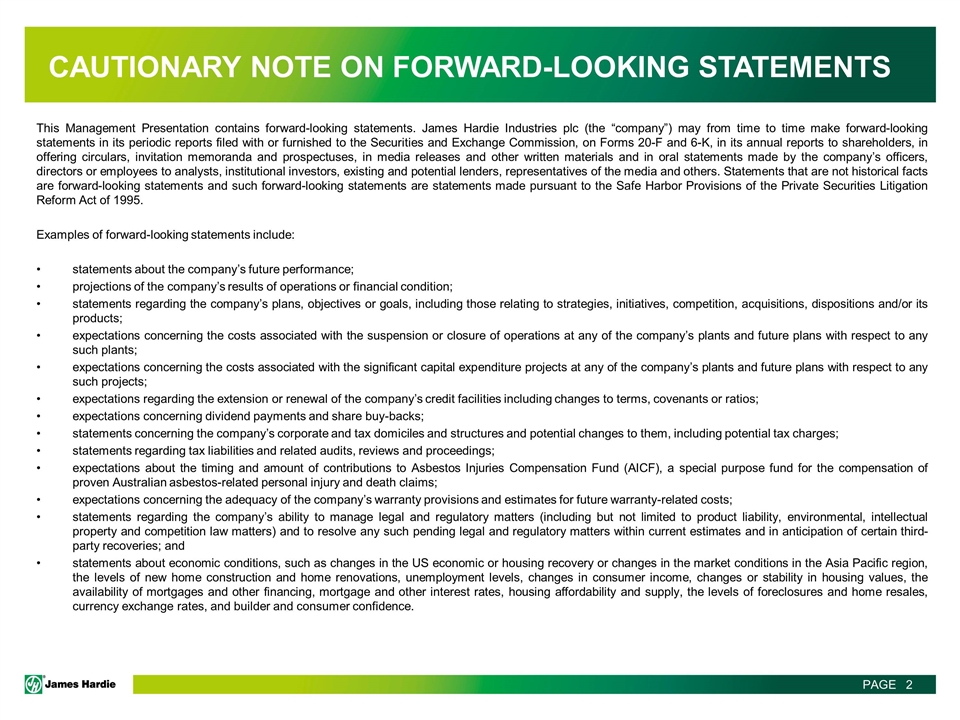
CAUTIONARY NOTE ON FORWARD-LOOKING STATEMENTS This Management Presentation contains forward-looking statements. James Hardie Industries plc (the “company”) may from time to time make forward-looking statements in its periodic reports filed with or furnished to the Securities and Exchange Commission, on Forms 20-F and 6-K, in its annual reports to shareholders, in offering circulars, invitation memoranda and prospectuses, in media releases and other written materials and in oral statements made by the company’s officers, directors or employees to analysts, institutional investors, existing and potential lenders, representatives of the media and others. Statements that are not historical facts are forward-looking statements and such forward-looking statements are statements made pursuant to the Safe Harbor Provisions of the Private Securities Litigation Reform Act of 1995. Examples of forward-looking statements include: statements about the company’s future performance; projections of the company’s results of operations or financial condition; statements regarding the company’s plans, objectives or goals, including those relating to strategies, initiatives, competition, acquisitions, dispositions and/or its products; expectations concerning the costs associated with the suspension or closure of operations at any of the company’s plants and future plans with respect to any such plants; expectations concerning the costs associated with the significant capital expenditure projects at any of the company’s plants and future plans with respect to any such projects; expectations regarding the extension or renewal of the company’s credit facilities including changes to terms, covenants or ratios; expectations concerning dividend payments and share buy-backs; statements concerning the company’s corporate and tax domiciles and structures and potential changes to them, including potential tax charges; statements regarding tax liabilities and related audits, reviews and proceedings; expectations about the timing and amount of contributions to Asbestos Injuries Compensation Fund (AICF), a special purpose fund for the compensation of proven Australian asbestos-related personal injury and death claims; expectations concerning the adequacy of the company’s warranty provisions and estimates for future warranty-related costs; statements regarding the company’s ability to manage legal and regulatory matters (including but not limited to product liability, environmental, intellectual property and competition law matters) and to resolve any such pending legal and regulatory matters within current estimates and in anticipation of certain third-party recoveries; and statements about economic conditions, such as changes in the US economic or housing recovery or changes in the market conditions in the Asia Pacific region, the levels of new home construction and home renovations, unemployment levels, changes in consumer income, changes or stability in housing values, the availability of mortgages and other financing, mortgage and other interest rates, housing affordability and supply, the levels of foreclosures and home resales, currency exchange rates, and builder and consumer confidence.

CAUTIONARY NOTE ON FORWARD-LOOKING STATEMENTS (continued) Words such as “believe,” “anticipate,” “plan,” “expect,” “intend,” “target,” “estimate,” “project,” “predict,” “forecast,” “guideline,” “aim,” “will,” “should,” “likely,” “continue,” “may,” “objective,” “outlook” and similar expressions are intended to identify forward-looking statements but are not the exclusive means of identifying such statements. Readers are cautioned not to place undue reliance on these forward-looking statements and all such forward-looking statements are qualified in their entirety by reference to the following cautionary statements. Forward-looking statements are based on the company’s current expectations, estimates and assumptions and because forward-looking statements address future results, events and conditions, they, by their very nature, involve inherent risks and uncertainties, many of which are unforeseeable and beyond the company’s control. Such known and unknown risks, uncertainties and other factors may cause actual results, performance or other achievements to differ materially from the anticipated results, performance or achievements expressed, projected or implied by these forward-looking statements. These factors, some of which are discussed under “Risk Factors” in Section 3 of the Form 20-F filed with the Securities and Exchange Commission on 19 May 2016, include, but are not limited to: all matters relating to or arising out of the prior manufacture of products that contained asbestos by current and former company subsidiaries; required contributions to AICF, any shortfall in AICF and the effect of currency exchange rate movements on the amount recorded in the company’s financial statements as an asbestos liability; governmental loan facility to AICF; compliance with and changes in tax laws and treatments; competition and product pricing in the markets in which the company operates; the consequences of product failures or defects; exposure to environmental, asbestos, putative consumer class action or other legal proceedings; general economic and market conditions; the supply and cost of raw materials; possible increases in competition and the potential that competitors could copy the company’s products; reliance on a small number of customers; a customer’s inability to pay; compliance with and changes in environmental and health and safety laws; risks of conducting business internationally; compliance with and changes in laws and regulations; currency exchange risks; dependence on customer preference and the concentration of the company’s customer base on large format retail customers, distributors and dealers; dependence on residential and commercial construction markets; the effect of adverse changes in climate or weather patterns; possible inability to renew credit facilities on terms favorable to the company, or at all; acquisition or sale of businesses and business segments; changes in the company’s key management personnel; inherent limitations on internal controls; use of accounting estimates; and all other risks identified in the company’s reports filed with Australian, Irish and US securities regulatory agencies and exchanges (as appropriate). The company cautions you that the foregoing list of factors is not exhaustive and that other risks and uncertainties may cause actual results to differ materially from those referenced in the company’s forward-looking statements. Forward-looking statements speak only as of the date they are made and are statements of the company’s current expectations concerning future results, events and conditions. The company assumes no obligation to update any forward-looking statements or information except as required by law.

NOTE TO THE READER As of 30 June 2016, the Company changed its reportable operating segments. Previously, the Company reported on three operating segments: (i) North America and Europe Fiber Cement, (ii) Asia Pacific Fiber Cement, and (iii) Research and Development. As of 30 June 2016, the Company reports on four operating segments: (i) North America Fiber Cement, (ii) International Fiber Cement, (iii) Other Businesses, and (iv) Research and Development. The significant changes to how certain businesses are reported in the new segment structure are as follows: (i) our European business is now reported in the International Fiber Cement segment, along with the other businesses that were historically reported in the Asia Pacific Fiber Cement segment, and (ii) business development, including some non-fiber cement operations, such as our Windows business in North America, are now reported in the Other Businesses segment as opposed to previously being reported in the North America and Europe Fiber Cement segment. The change in reportable segments had no effect on the Company’s financial position, results of operations or cash flows for the periods presented. Readers are referred to Note 14 of our condensed consolidated financial statements for the period ended 30 June 2016 for further information on our segments.
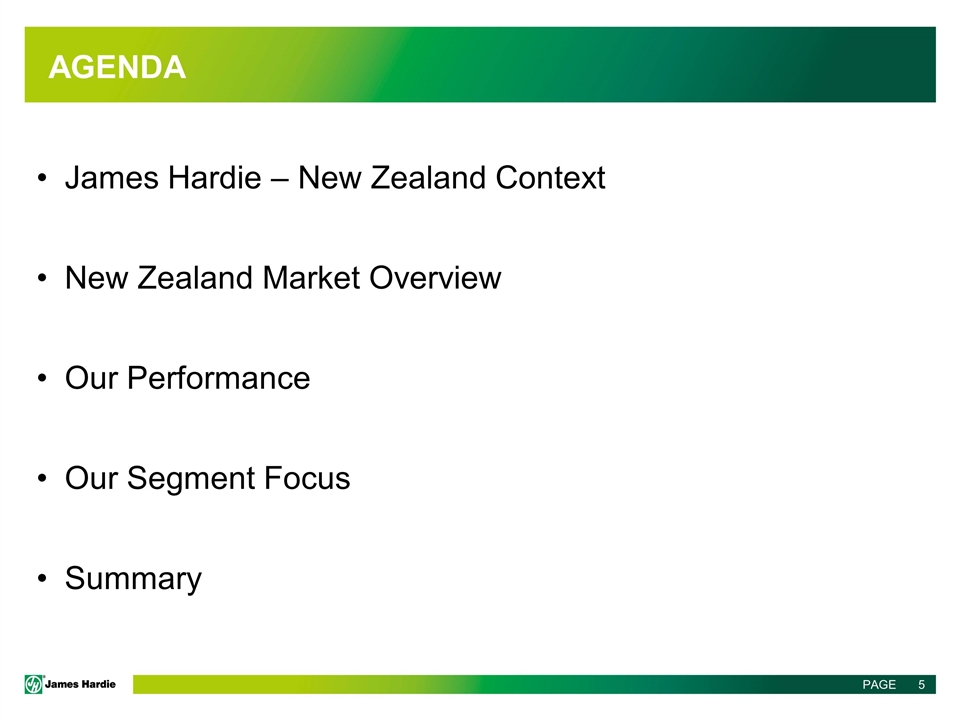
AGENDA James Hardie – New Zealand Context New Zealand Market Overview Our Performance Our Segment Focus Summary
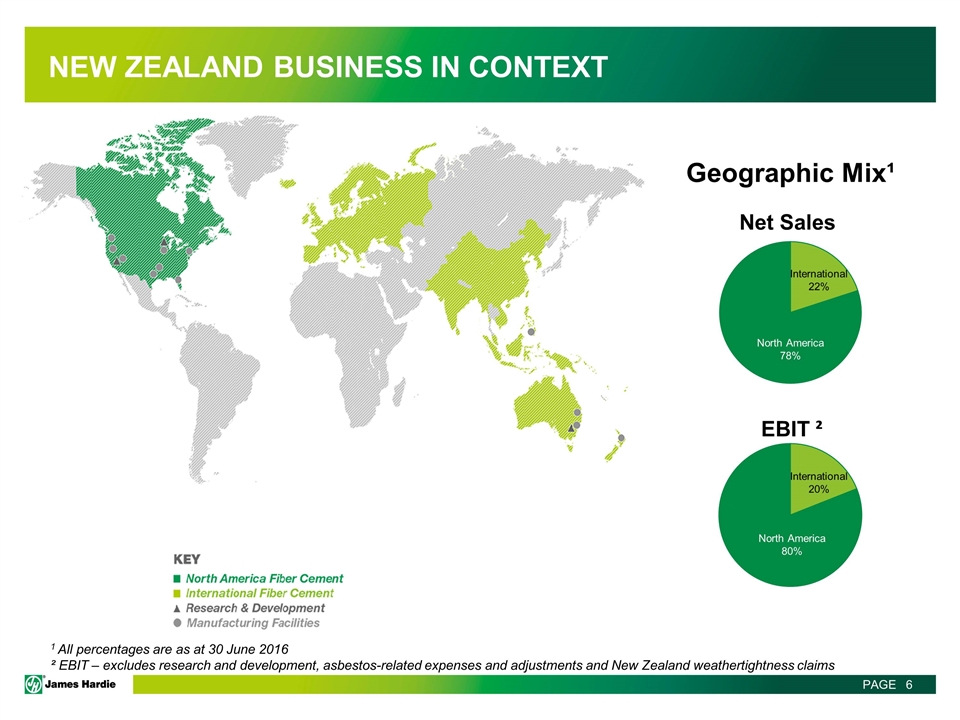
NEW ZEALAND BUSINESS IN CONTEXT Geographic Mix¹ Net Sales EBIT ² 1 All percentages are as at 30 June 2016 ² EBIT – excludes research and development, asbestos-related expenses and adjustments and New Zealand weathertightness claims International 20% International 22% North America 80%

WE OPERATE IN THE NEW ZEALAND BUILDING AND CONSTRUCTION MARKET, WITH A FOCUS ON BUILDINGS WHERE PEOPLE LIVE AND WORK Renovation Commercial Attached Medium density Detached

STRONG FUNDAMENTALS DRIVING NEW HOME GROWTH Value of all Construction Nationally (Historic and Forecast) Source: BRANZ/Pacifecon Strong fundamentals of low interest rates, population growth and investor activity is expected to prolong the upside in new residential activity for the remainder of FY17 and into FY18
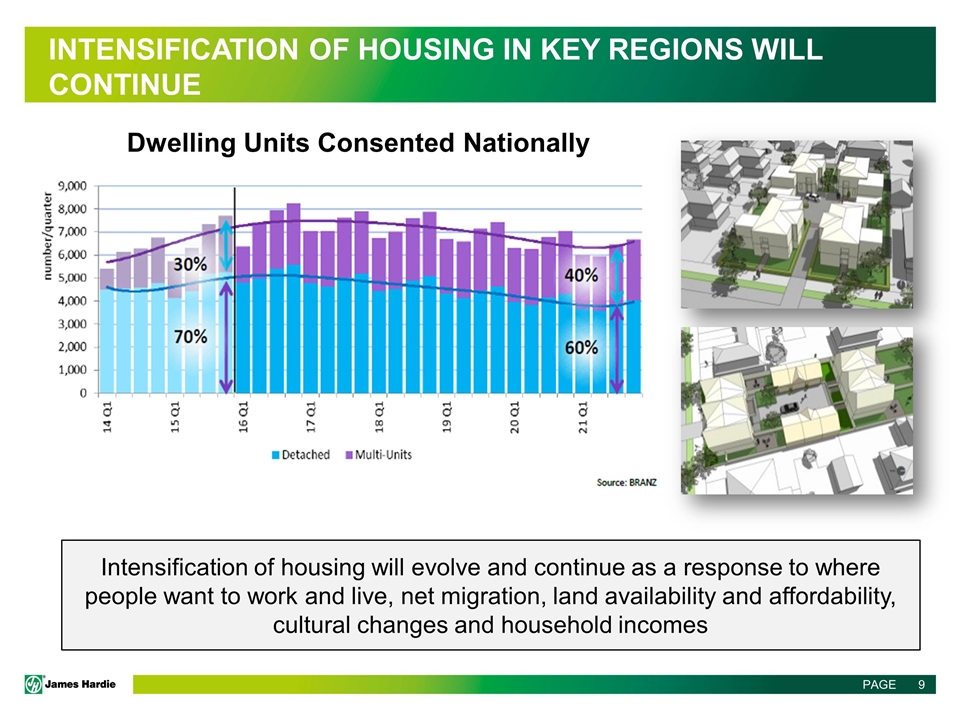
INTENSIFICATION OF HOUSING IN KEY REGIONS WILL CONTINUE Intensification of housing will evolve and continue as a response to where people want to work and live, net migration, land availability and affordability, cultural changes and household incomes Dwelling Units Consented Nationally
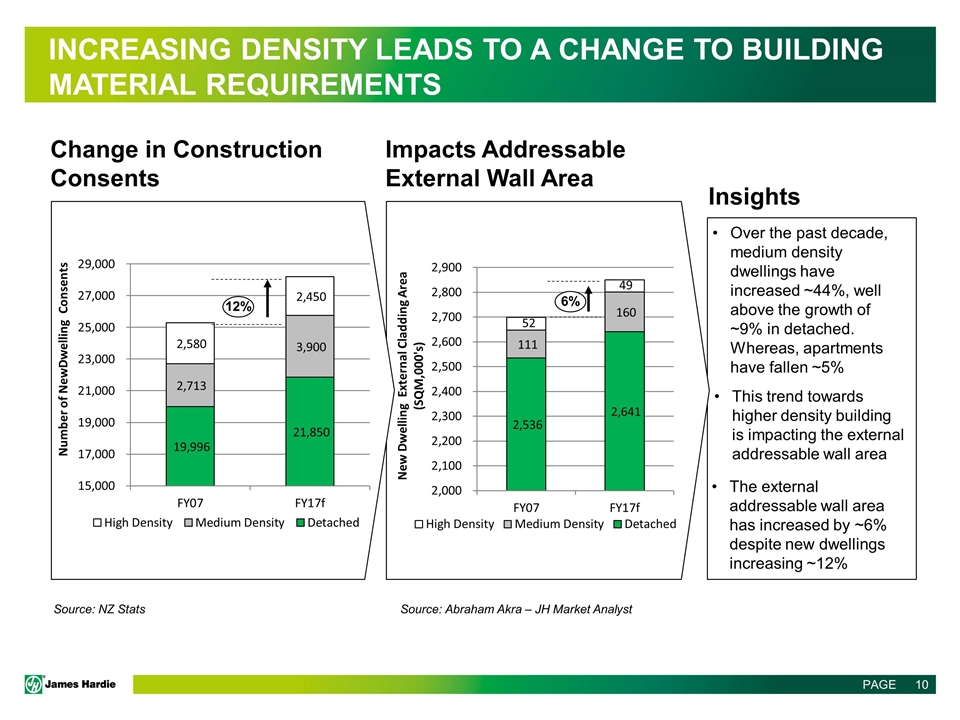
INCREASING DENSITY LEADS TO A CHANGE TO BUILDING MATERIAL REQUIREMENTS Over the past decade, medium density dwellings have increased ~44%, well above the growth of ~9% in detached. Whereas, apartments have fallen ~5% This trend towards higher density building is impacting the external addressable wall area 6% The external addressable wall area has increased by ~6% despite new dwellings increasing ~12% Source: NZ Stats Source: Abraham Akra – JH Market Analyst Change in Construction Consents Impacts Addressable External Wall Area Insights

WE CONTINUE TO AGGRESSIVELY GROW DEMAND FOR OUR PRODUCTS Since the 2010, volume and revenue have increased by more than 25% PDG (sales growth above the market) has consistently been achieved New Zealand Local Top Line Growth (Rolling 12 Months)
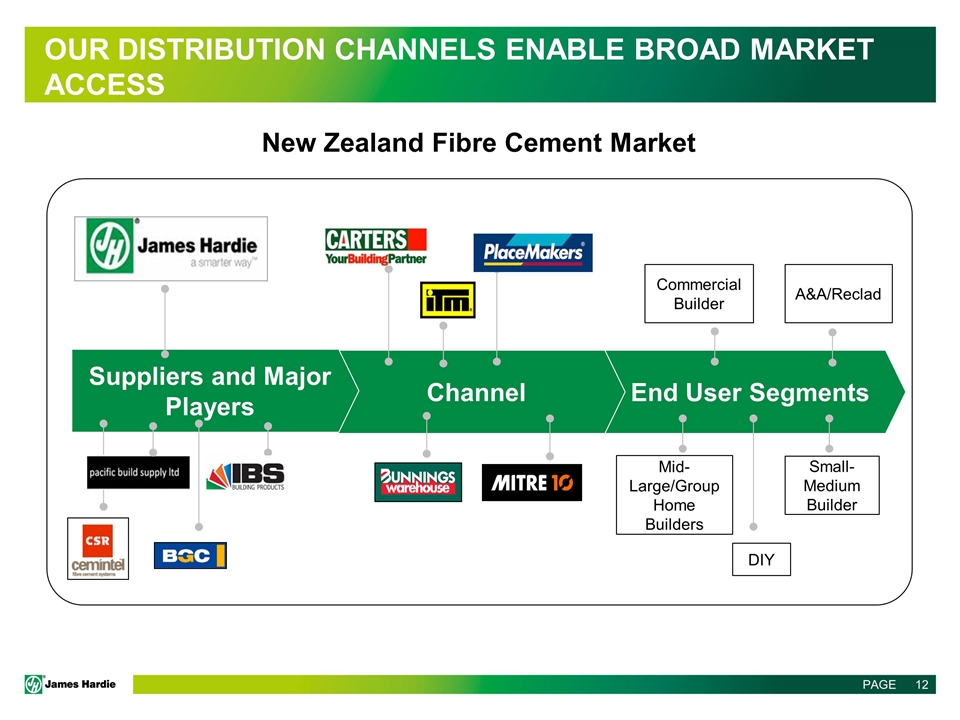
End User Segments Channel Suppliers and Major Players Mid-Large/Group Home Builders DIY Small-Medium Builder Commercial Builder A&A/Reclad OUR DISTRIBUTION CHANNELS ENABLE BROAD MARKET ACCESS New Zealand Fibre Cement Market
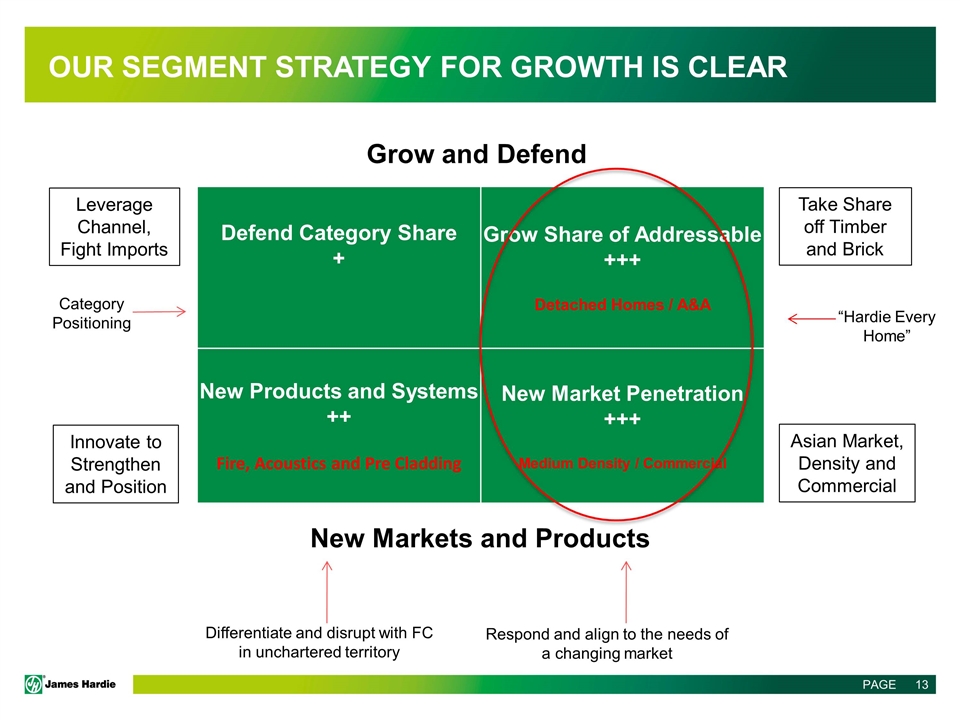
OUR SEGMENT STRATEGY FOR GROWTH IS CLEAR Defend Category Share + Grow Share of Addressable +++ Detached Homes / A&A New Products and Systems ++ Fire, Acoustics and Pre Cladding New Market Penetration +++ Medium Density / Commercial Take Share off Timber and Brick Asian Market, Density and Commercial Innovate to Strengthen and Position Leverage Channel, Fight Imports Differentiate and disrupt with FC in unchartered territory Respond and align to the needs of a changing market “Hardie Every Home” Category Positioning Grow and Defend New Markets and Products
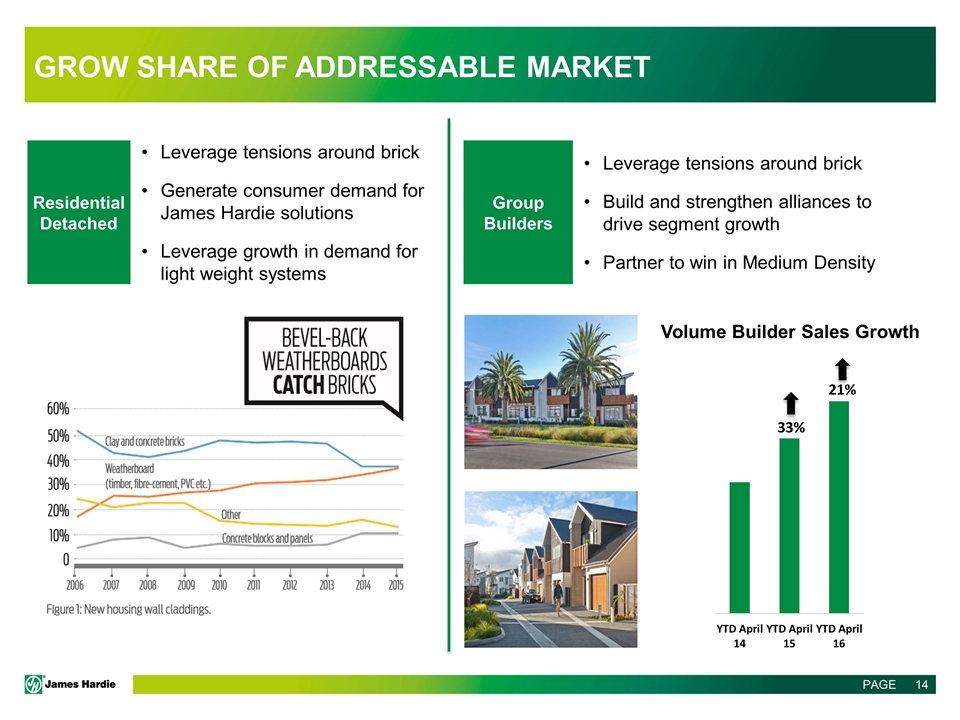
GROW SHARE OF ADDRESSABLE MARKET Residential Detached Leverage tensions around brick Generate consumer demand for James Hardie solutions Leverage growth in demand for light weight systems Group Builders Leverage tensions around brick Build and strengthen alliances to drive segment growth Partner to win in Medium Density 33% 21% Volume Builder Sales Growth

GROW SHARE OF ADDRESSABLE MARKET Commercial Partner for design built solutions Conversion of wet trades – win with WALL and FLOOR Solutions Additions & Alterations Partner with channel to access SME’s Education through aggregation events Onsite training with LBP Builders Target consent range: $50k - $250k Floor Solutions Lightweight Floor Onsite efficiencies No delays Wall Solutions Fire and Acoustic Light Weight Onsite efficiencies Residential Consent Value: New vs Alternations
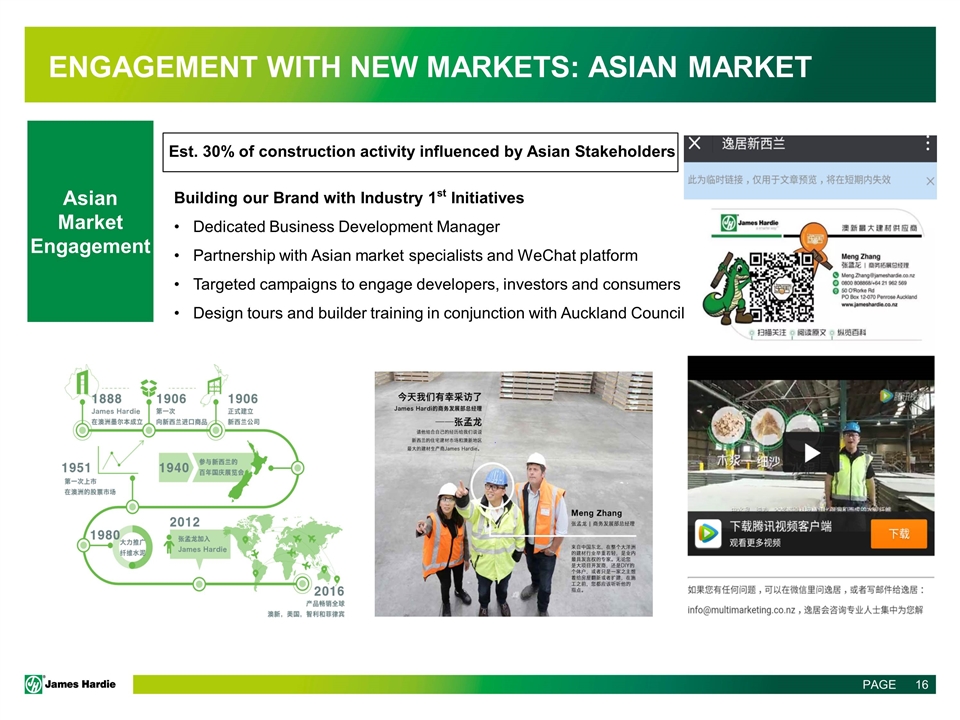
ENGAGEMENT WITH NEW MARKETS: ASIAN MARKET Asian Market Engagement Building our Brand with Industry 1st Initiatives Dedicated Business Development Manager Partnership with Asian market specialists and WeChat platform Targeted campaigns to engage developers, investors and consumers Design tours and builder training in conjunction with Auckland Council Est. 30% of construction activity influenced by Asian Stakeholders
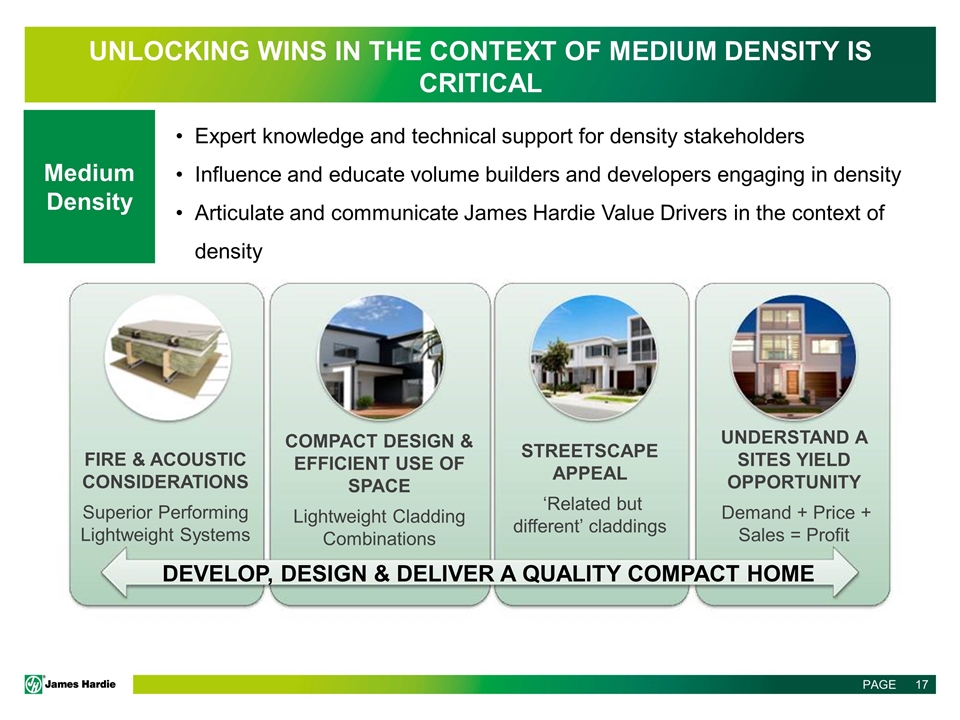
UNLOCKING WINS IN THE CONTEXT OF MEDIUM DENSITY IS CRITICAL Medium Density Expert knowledge and technical support for density stakeholders Influence and educate volume builders and developers engaging in density Articulate and communicate James Hardie Value Drivers in the context of density FIRE & ACOUSTIC CONSIDERATIONS Superior Performing Lightweight Systems COMPACT DESIGN & EFFICIENT USE OF SPACE Lightweight Cladding Combinations STREETSCAPE APPEAL ‘Related but different’ claddings UNDERSTAND A SITES YIELD OPPORTUNITY Demand + Price + Sales = Profit DEVELOP, DESIGN & DELIVER A QUALITY COMPACT HOME
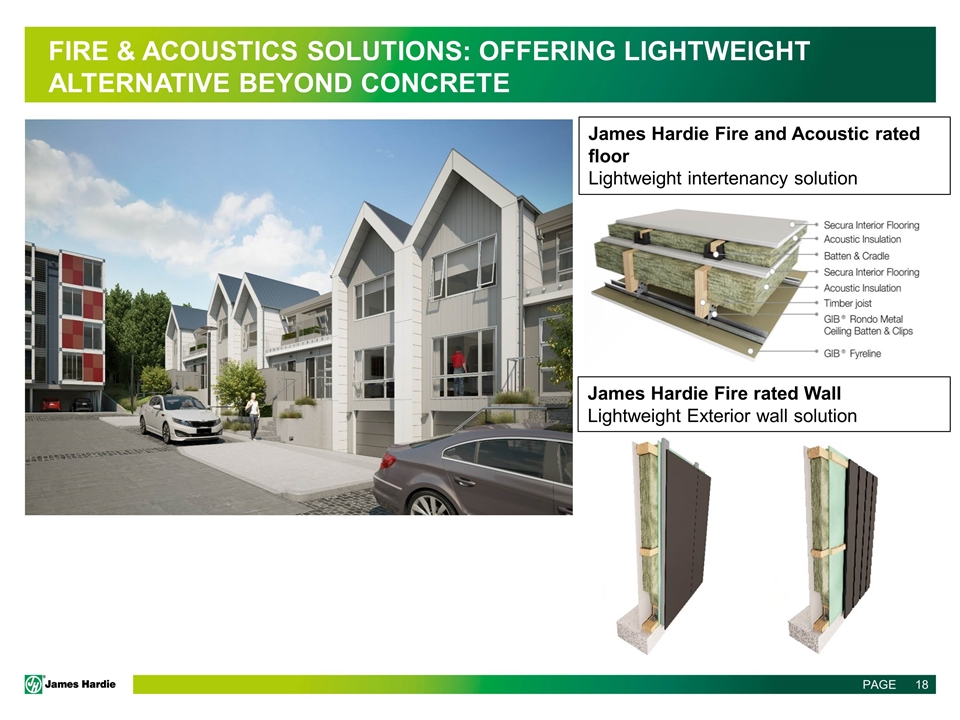
FIRE & ACOUSTICS SOLUTIONS: OFFERING LIGHTWEIGHT ALTERNATIVE BEYOND CONCRETE James Hardie Fire and Acoustic rated floor Lightweight intertenancy solution James Hardie Fire rated Wall Lightweight Exterior wall solution
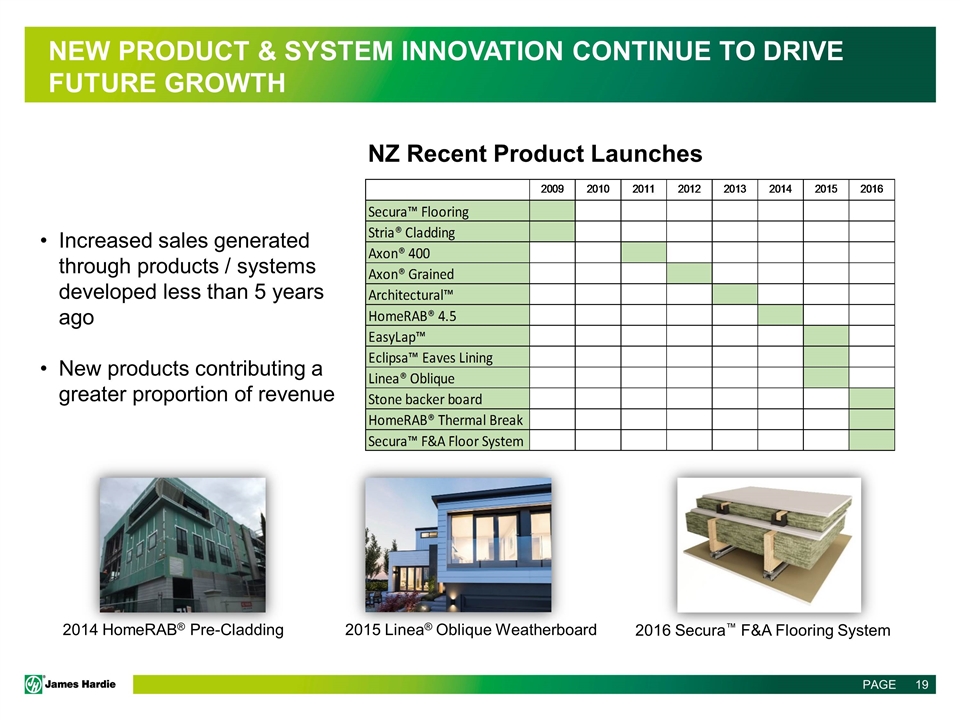
NEW PRODUCT & SYSTEM INNOVATION CONTINUE TO DRIVE FUTURE GROWTH NZ Recent Product Launches 2014 HomeRAB® Pre-Cladding 2015 Linea® Oblique Weatherboard 2016 Secura™ F&A Flooring System Increased sales generated through products / systems developed less than 5 years ago New products contributing a greater proportion of revenue
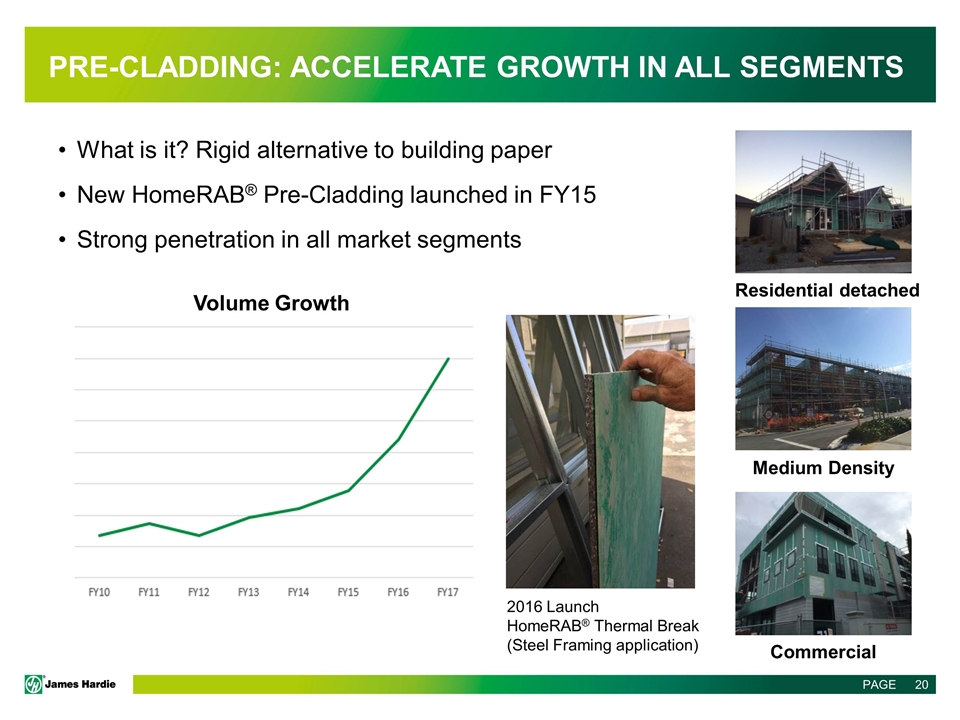
PRE-CLADDING: ACCELERATE GROWTH IN ALL SEGMENTS What is it? Rigid alternative to building paper New HomeRAB® Pre-Cladding launched in FY15 Strong penetration in all market segments 2016 Launch HomeRAB® Thermal Break (Steel Framing application) Residential detached Medium Density Commercial Volume Growth
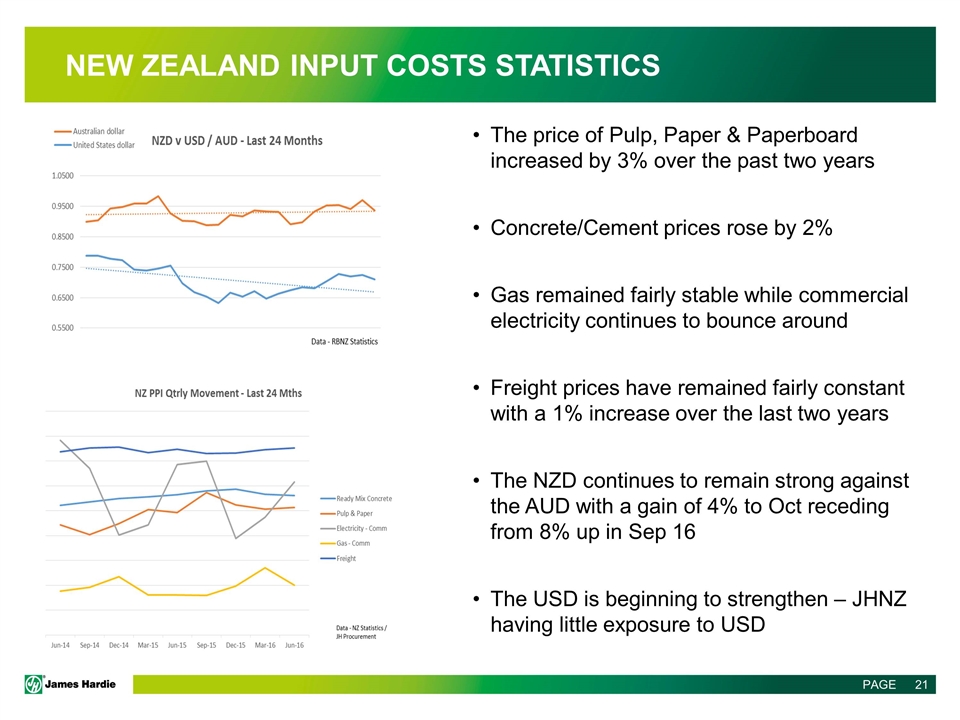
NEW ZEALAND INPUT COSTS STATISTICS The price of Pulp, Paper & Paperboard increased by 3% over the past two years Concrete/Cement prices rose by 2% Gas remained fairly stable while commercial electricity continues to bounce around Freight prices have remained fairly constant with a 1% increase over the last two years The NZD continues to remain strong against the AUD with a gain of 4% to Oct receding from 8% up in Sep 16 The USD is beginning to strengthen – JHNZ having little exposure to USD
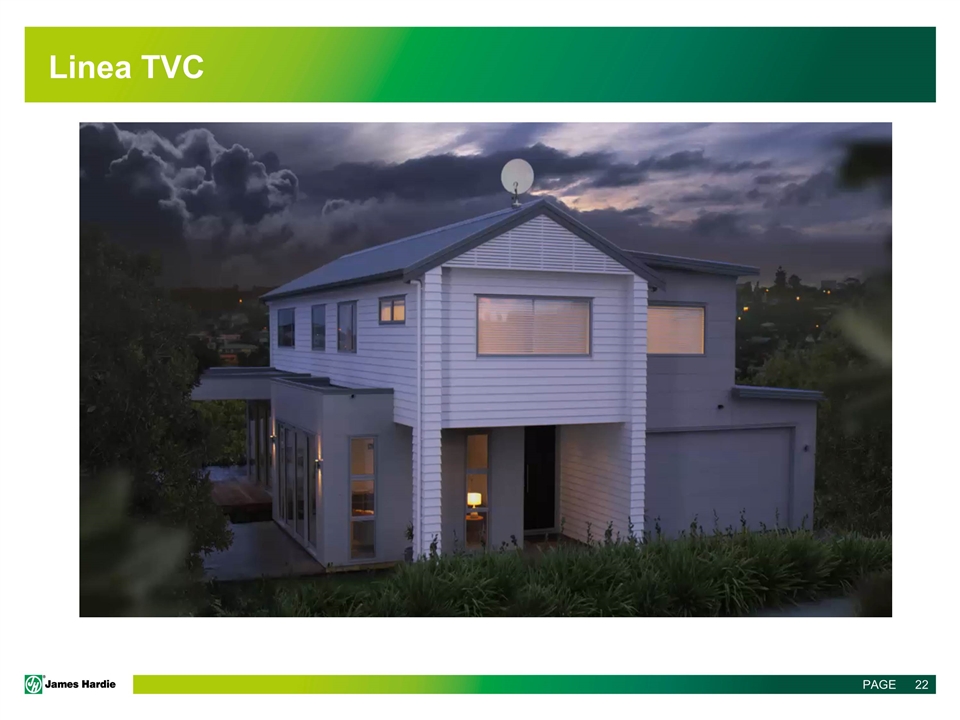
Linea TVC

IN SUMMARY The New Zealand construction market is expected to remain strong in the medium term James Hardie New Zealand is well positioned to continue to achieve primary demand growth, supported by a clear segment penetration strategy We remain focused on the innovation and development of new products and building solutions to further support growth

QUESTIONS